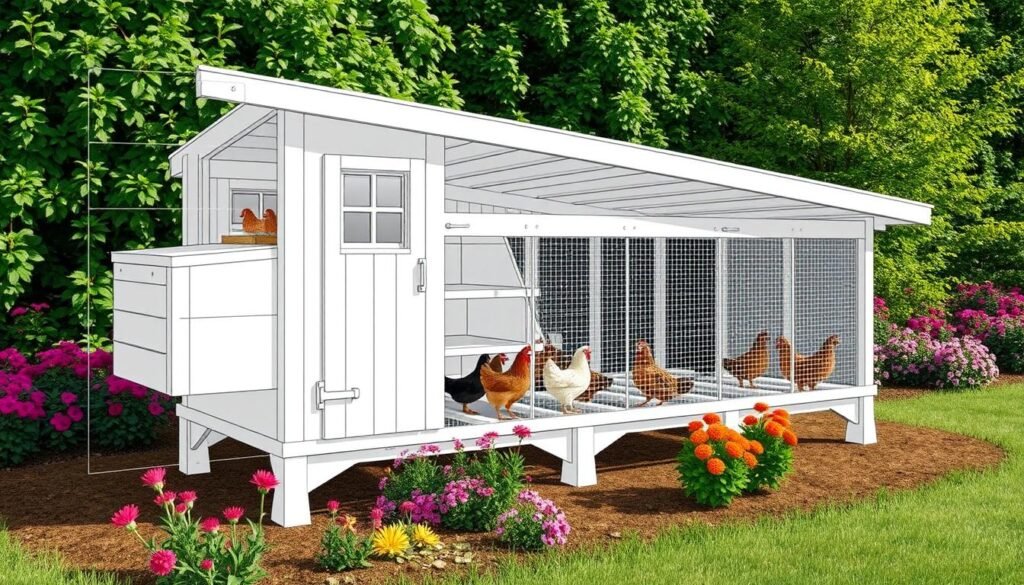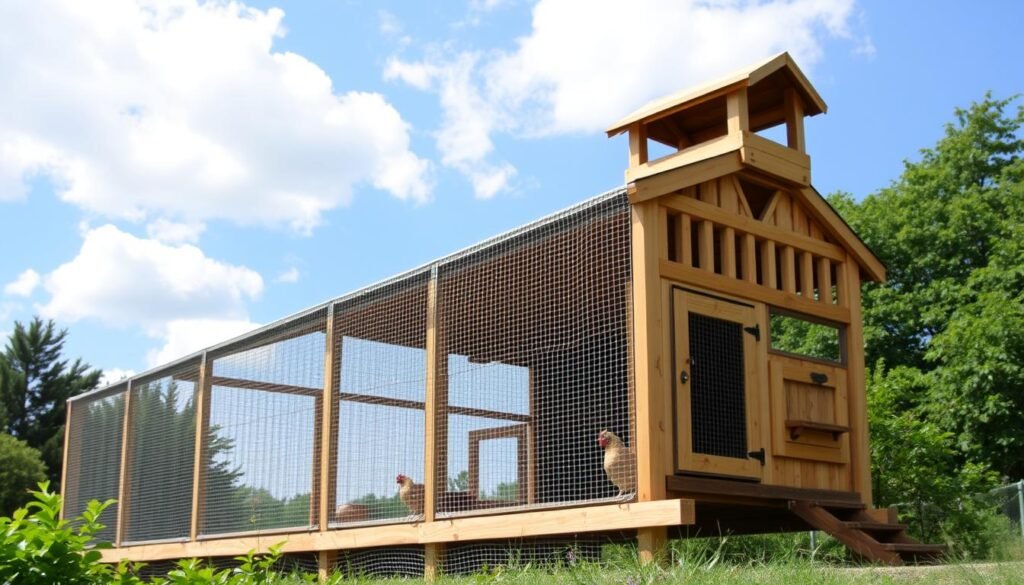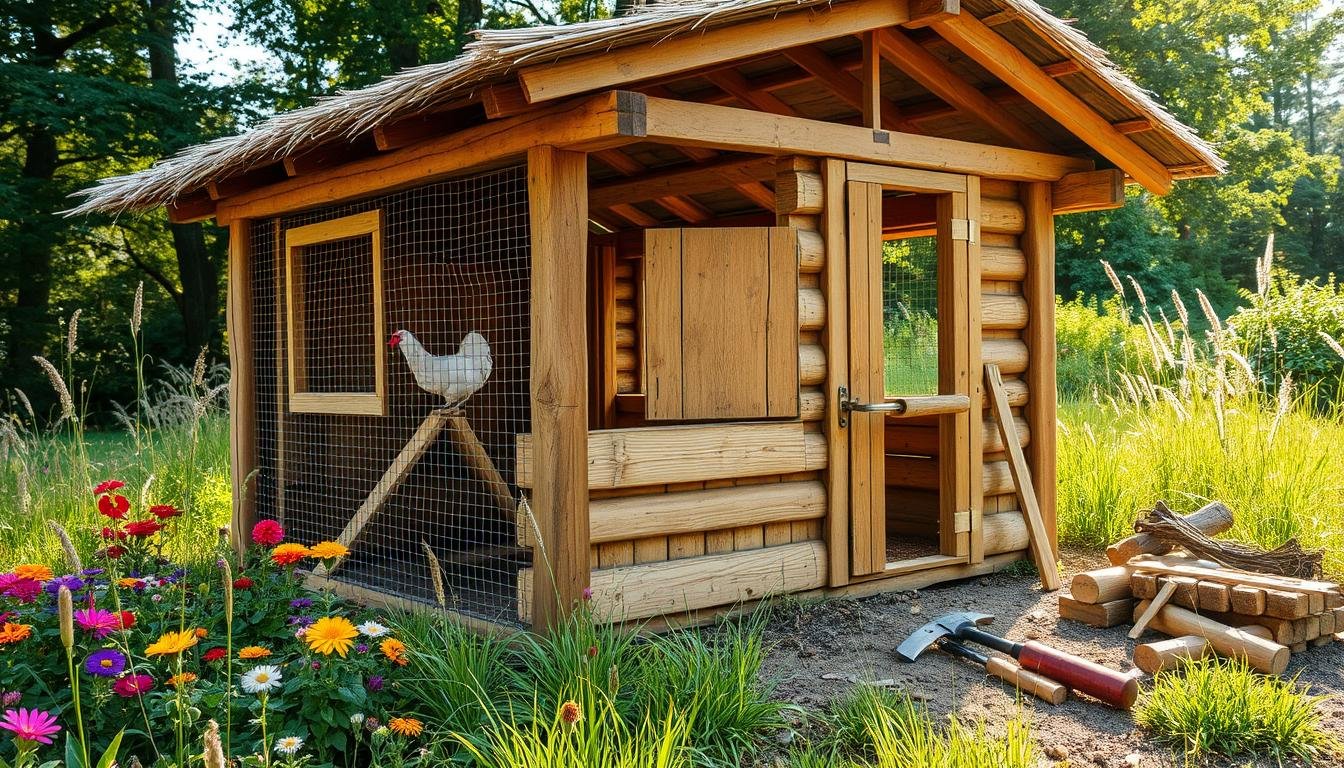Imagine waking up to the sound of your hens clucking and the promise of fresh eggs. Raising chickens is rewarding, and it starts with a great chicken coop. I’ve been there, measuring out space and planning for my flock. It’s a labor of love, from planning to the last nail.
Building a coop is more than just wood. It’s about creating a safe home for your birds. Whether you’re building from scratch or using plans, every decision matters. Ready to make your backyard a chicken paradise?
Key Takeaways
- Allocate 2-3 square feet of coop space per standard size chicken.
- Use durable, weather-resistant materials for construction.
- Provide one nesting box for every 4-5 laying hens.
- Ensure perches are around 4 cm square with rounded edges.
- Replace bedding at least twice a year for cleanliness.
Why Building a Great Chicken Coop Matters
In the world of poultry, the importance of building a great chicken coop is huge. A well-made coop is a safe place for your chickens to live. It makes them happy and healthy. Let’s look at why a good coop is important and what mistakes to avoid.
Benefits of a Well-Designed Coop
A good coop keeps chickens safe from predators, bad weather, and cold. This helps them lay more eggs and feel less stressed.
- Space Efficiency: Giving chickens enough room, about 2-3 square feet inside and 4 square feet outside, makes them comfortable. It also stops them from fighting.
- Optimal Ventilation: Good air flow in the coop stops sickness like Newcastle and bird flu.
- Efficient Layout: A coop with the right nesting boxes and roosts is comfy for chickens. It also makes collecting eggs easier.
Common Pitfalls to Avoid
Building a coop wrong can really hurt your chickens. Not having enough space, using bad materials, or not keeping predators out can harm them.
- Inadequate Space: Hens need 8-10 square feet of room if they’re stuck inside. Less space can cause stress and fighting.
- Insufficient Shelter: Without good insulation and protection from predators, chickens face dangers from the environment and predators.
- Poor Ventilation: Not having enough air flow in the coop can cause moisture. This leads to sickness.
- Improper Perches: Chickens need at least 8 inches of roost space. Less than that makes them uncomfortable and restless.
Following these coop building tips will help you create a happy and productive backyard coop.
Key Elements of Chicken Coop Design
Building a chicken coop that meets your flock’s needs can make raising chickens more enjoyable. It’s important to consider size, materials, and location. These factors greatly impact your poultry house plans’ success.
Size and Space Requirements
Ensuring your chickens have enough space is crucial. The minimum inside space needed is 4 square feet per bird. However, it’s wise to plan for the future by building a coop for more chickens than you currently have. For example, if you start with six chickens, aim for a design for twelve.
The run should also provide at least 10 square feet per bird. This prevents feather pecking and keeps your flock happy and healthy.
Choosing the Right Materials
Durability and safety are key when choosing materials. Wood is a good choice because it’s sturdy and easy to maintain. However, it needs to be treated to withstand the elements and pests.
Elevated coops with wooden floors can deter rats and other predators. Make sure to include ventilation high up on the walls to remove moisture and harmful ammonia. Windows should be placed to allow natural light, which is essential for egg production.
Placement and Location Tips
The coop’s location is crucial. Choose a spot that provides shade to protect your flock from heat. Ensure the coop is on high ground to prevent flooding and moisture buildup.
Access to natural light is vital, so include windows on multiple walls. Building a roof over the run allows chickens to enjoy the outdoors, regardless of the weather. Always include a dust bath area to maintain their plumage.

When planning your poultry house, include a secure area for feed and cleaning supplies. A well-organized coop with separate storage can make daily chores easier. Consider these elements to create a functional and efficient space for raising chickens.
| Coop Element | Recommendation |
|---|---|
| Minimum Inside Space | 4 square feet per bird |
| Chicken Run Space | 10 square feet per bird |
| Roosting Space | 8-12 inches per bird |
| Nesting Boxes | One per four chickens |
| Ventilation | High up on walls |
| Natural Light | Windows for light exposure |
| Run Roofing | Cover the chicken run |
| Dust Bath Areas | Provide sand or dirt |
Essential Features Inside a Chicken Coop
Building the perfect chicken coop requires careful planning. You need to include key features to keep your chickens happy and healthy. Are you ready to learn about these important tips?
Nesting Boxes
Nesting boxes are vital for hens to lay eggs. Experts say you need one box for every four to five hens. For big chickens, the box should be 14″ wide, 14″ high, and 12″ deep.
Place nesting boxes below the perches to stop hens from roosting there. Remember to keep the boxes clean with fresh litter.
Perches and Roosting Bars
Perches and roosting bars must be comfortable for your chickens. Give each chicken about 30 cm of space on the perch. Make sure the perches are away from drafts to keep them warm.
Feeders and Waterers
Feeders and waterers must be placed correctly. They should be at least 25 cm off the ground to avoid dirt and pests. Clean them often so your chickens always have clean food and water.
Starting your chicken coop project means adding these features to your plans. These tips help create a safe and productive space for your chickens.
Ventilation and Lighting for a Healthy Flock
Creating a cozy and healthy chicken housing environment is key. It depends on good ventilation and lighting in your chicken coop design.
Good coop ventilation is vital for air quality. It stops ammonia buildup and keeps your flock healthy. Use windows, air vents near the roof, and a cupola for airflow.
Make sure to cover these openings with ¼” hardwire cloth. This keeps predators out and keeps your coop safe.
Lighting is also crucial for your flock’s health. Windows on the east and west sides let in natural light. If more light is needed, use LED rope lights. They’re safe and efficient, adding to the natural light.
A well-designed chicken coop with good ventilation and lighting is key. It helps your flock stay strong and lively.
Predator-Proofing Your Chicken Coop
Keeping your chickens safe is all about smart design and being proactive. Let’s explore the key steps to make your chicken coop safe from predators.
Security Measures
Start by checking your coop for any gaps. Use strong materials like treated lumber and hardware cloth. Also, make sure the doors are locked securely.
Look at examples like the coop on From Scratch Farmstead. It shows a 0% loss rate over five years. Burying wire at least a foot deep can stop digging predators.
To keep your coop stable, use strong posts like 4″x4″ treated lumber. These should be three feet deep in the ground, anchored with concrete. 
Safe Fencing Options
Fencing is key for safe poultry housing. Use strong materials like galvanized or stainless steel mesh. Add skirt boards and covered runs for extra security and weather protection.
A raised chicken coop also helps by keeping chickens off the ground. This adds an extra layer of protection. Roll-away nesting boxes help keep eggs clean and reduce predator attraction.
For more building tips, check out the deck framing essentials guide. It’s great for building lasting structures.
Using motion-activated deterrents like reflective materials or noise-makers can help keep predators away. This makes your chicken coops even safer.
DIY Chicken Coop Ideas for Various Budgets
Building a diy chicken coop on a budget is easy with creativity. You can make a safe and cozy home for your chickens without spending a lot. Here’s how to start:
When building a great chicken coop, think about using old stuff. Old pallets can become nesting boxes, saving money. A simple A-frame coop can cost under $50, and cheaper materials can make it even cheaper.
Local resources are key for budget coop designs. For example:
- Yard sales or second-hand stores have great deals on materials.
- Farmers might give away free hay or straw for coop flooring.
- Old branches are perfect for roost bars without extra cost.
- Old children’s playsets or IKEA bed frames can become a coop run.
DIY projects save money compared to buying a coop. A fancy coop costs about $4,000, but a diy chicken coop costs around $150. Some builders even built coops for just $30.
Not sure where to begin? Here are some key things to think about:
| Element | Recommendation |
|---|---|
| Coop Space | 2-4 square feet per hen |
| Nesting Boxes | One per 3-4 birds |
| Roost Bars | 2-4 inches wide, one foot apart |
| Ventilation | Two windows on both sides |
An elevated coop base helps with predators and moisture. Using chicken wire keeps your chickens safe. Also, think about adding ramps for easy access and strong feeders and waterers. These budget coop designs offer ideas for your next DIY project, whether you’re frugal or like a fancy setup.
Urban Coop Ideas: Raising Chickens in the City
Raising chickens in the city might seem tough, but it can be fun and rewarding. Urban coop ideas help by using space well and following local rules.
Compact Coop Designs
City chicken keeping is all about creative and space-saving compact chicken coops. You can use vertical designs and raised coops to save space. For example, Lisa Steele’s Dreamy Purchased Coop was built by Horizon Structures and delivered in one piece. It’s both practical and pretty.
Many city chicken keepers choose coops like the Pretty & Simple Chicken Coop by Christi Wilson. It’s great for 6 to 9 chickens and fits well in a small backyard. The Small Chicken Coop & Run with Window Box Plans at mypetchicken.com are also good for small patios, holding 4 to 5 chickens.
Community Guidelines
Before starting with city chicken keeping, it’s key to know the community rules. These rules might cover noise, bird numbers, and waste. Looking at plans like the Quaint Coop & Run on Etsy is a good idea. It’s for up to 10 chickens and has features like an angled roost and droppings board.
Security is also very important. Urban areas can have predators like stray dogs or rodents. Strong fencing and secure latches are essential to keep your chickens safe. For more tips, check out this link.
Knowing these things and picking the right urban coop ideas can make city chicken keeping a success.
Maintaining Cleanliness: Best Practices
Keeping your chicken coop clean is key for a healthy and happy flock. It helps cut down on diseases, pests, and bad smells. And it’s simpler than you might think!
Choosing the Right Bedding
The right bedding is crucial for cleanliness. Hemp and wood shavings are top choices because they soak up moisture and are safe for chickens. They also fight mold well. This bedding makes composting easier, adding to your eco-friendly chicken care.
Effective Cleaning Routines
Start with regular upkeep for effective cleaning. Clean spots daily and change bedding weekly. Also, do a deep clean in spring by removing all waste and scrubbing down. Finish with vinegar and let it dry in the sun.
Sanitation Tips
Sanitation goes beyond cleaning. Clean feeders and waterers often and replace old bedding. Use pest control like Bugs Away for new bedding. Don’t forget about flies in summer. The deep litter method is also a good, low-maintenance option.
Seasonal Considerations for Your Coop
As seasons change, your chickens’ needs change too. It’s important to keep your coop in top shape all year round. Here’s how to handle both cold winters and hot summers.
Winterizing Your Coop
Insulation is key when winterizing your coop. Start by covering windows with plastic to keep drafts out. But, make sure you don’t block all ventilation. Good airflow helps prevent ammonia buildup.
Use dry bedding like wood shavings to keep your coop warm. It also helps with composting. Make sure the floor is safe from predators by using concrete or hardware cloth. Raising the coop helps keep it cold and pest-free.
Protect your chickens’ combs and wattles from frostbite with coconut oil. Choose breeds like Brahmas or Jersey Giants for their cold tolerance.
Summer Cooling Strategies
Keeping your coop cool in summer is just as important. Place the coop in a shaded area to avoid direct sunlight. Waterproofing the roof helps keep it cool too. Good ventilation is key to prevent overheating.
Give your chickens cool treats like veggies or install swings for fun. Elevated coops help with air circulation, keeping the area cool.
Make sure your chickens have plenty of fresh water, especially on hot days. Choose breeds with smaller combs for hotter climates.
| Seasonal Task | Winter | Summer |
|---|---|---|
| Coop Insulation | Essential | Minimal |
| Ventilation | Maintain Good Airflow | Maximize Air Circulation |
| Bedding Material | Dry Wood Shavings | Cooling Sources |
| Predator-proofing | Concrete Layer | Elevated Coop |
| Chicken Health | Coconut Oil for Comb Protection | Electrolytes in Water |
Integrating Tech into Chicken Coop Management
Adding tech to chicken coop management boosts security and convenience. It includes automated systems and environmental controls. These advancements change how we care for our poultry.
Automated Door Systems
Automated door systems bring safety and ease to chicken housing. They open and close based on schedules or light levels. This cuts down predator risks.
A typical setup includes an automatic door with a solar panel. It works from -15°F to 140°F (-26°C to 60°C). This is key for *smart coop management*. An electric actuator like the PA-14 Mini from Progressive Automations adds reliability.
Temperature Control Devices
Temperature control devices keep chickens comfortable. They range from simple thermostats to complex systems. A DHT11 sensor measures temperature and humidity accurately.
Using these sensors with a smart platform tracks data in real-time. The ESP8266 module for WiFi connectivity makes it easy to monitor from anywhere. This setup improves chicken living conditions and makes coop management easier.
Automation makes coop management simpler and improves chicken living conditions. Dual feeders and sprinkler systems ensure chickens are always fed and hydrated. This creates a more efficient *automated chicken housing* system.
For more on outdoor settings, learning about building durable structures is helpful. Learn more about constructing robust environments that match your advanced chicken coop tech.
Conclusion
Raising chickens well means building a coop that meets their needs. You should know the basics, like using good materials and keeping it clean. Remember, each chicken needs about 4 square feet of space, but some breeds need less or more.
Make sure your coop has nesting boxes and perches for comfort. Use strong fencing to keep them safe. Also, think about how to keep your chickens cool and warm all year.
Insulating your coop is key for comfort in hot and cold weather. With smart planning and the right tools, like automated doors, your coop can be modern and efficient. Place it about 30 feet from your house to avoid smells and mess.
Creating a great chicken coop is about more than just building it. It’s about making a happy home for your chickens. When you plan carefully, you’ll see the joy of raising chickens. So, start building and enjoy the happy sounds from your chickens!


